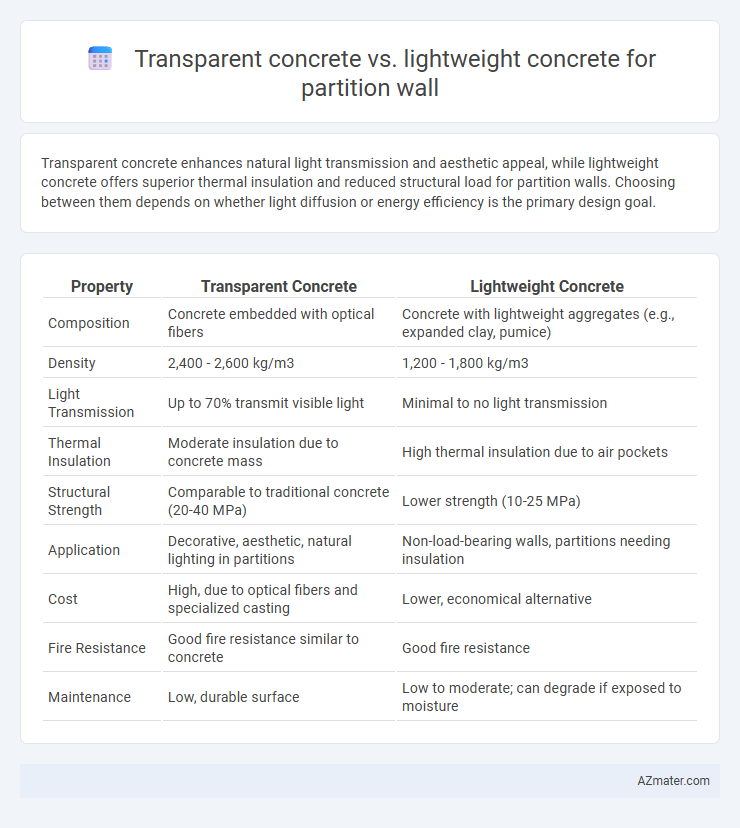Transparent concrete enhances natural light transmission and aesthetic appeal, while lightweight concrete offers superior thermal insulation and reduced structural load for partition walls. Choosing between them depends on whether light diffusion or energy efficiency is the primary design goal.
Table of Comparison
| Property | Transparent Concrete | Lightweight Concrete |
|---|---|---|
| Composition | Concrete embedded with optical fibers | Concrete with lightweight aggregates (e.g., expanded clay, pumice) |
| Density | 2,400 - 2,600 kg/m3 | 1,200 - 1,800 kg/m3 |
| Light Transmission | Up to 70% transmit visible light | Minimal to no light transmission |
| Thermal Insulation | Moderate insulation due to concrete mass | High thermal insulation due to air pockets |
| Structural Strength | Comparable to traditional concrete (20-40 MPa) | Lower strength (10-25 MPa) |
| Application | Decorative, aesthetic, natural lighting in partitions | Non-load-bearing walls, partitions needing insulation |
| Cost | High, due to optical fibers and specialized casting | Lower, economical alternative |
| Fire Resistance | Good fire resistance similar to concrete | Good fire resistance |
| Maintenance | Low, durable surface | Low to moderate; can degrade if exposed to moisture |
Introduction to Partition Wall Materials
Partition walls require materials that balance strength, weight, and aesthetic appeal. Transparent concrete incorporates optical fibers to allow light transmission while maintaining structural integrity, making it suitable for visually striking interiors. Lightweight concrete, composed with lightweight aggregates such as expanded clay or shale, offers reduced load on building frameworks and enhanced thermal insulation, optimizing energy efficiency in partition applications.
Overview of Transparent Concrete
Transparent concrete, also known as light-transmitting concrete, incorporates optical fibers to allow natural light to pass while maintaining structural integrity, making it an innovative choice for partition walls that require both privacy and illumination. This material typically exhibits a density similar to traditional concrete but with enhanced aesthetic appeal and energy efficiency due to increased daylight penetration. Lightweight concrete, in contrast, offers superior thermal insulation and easier handling but lacks the unique light transmission properties that characterize transparent concrete.
Overview of Lightweight Concrete
Lightweight concrete is a versatile building material characterized by its low density, which ranges from 800 to 1600 kg/m3, making it ideal for partition walls that demand reduced load on structural elements. Its composition typically includes lightweight aggregates such as expanded clay, shale, or pumice, enhancing thermal insulation and fire resistance properties compared to traditional concrete. Lightweight concrete offers improved acoustic performance and ease of installation, contributing to energy efficiency and cost savings in interior partition applications.
Material Composition and Structure Comparison
Transparent concrete incorporates optical fibers embedded within a cement matrix, allowing light transmission while maintaining structural integrity, making it ideal for aesthetic partition walls. Lightweight concrete uses aggregates such as expanded clay or pumice combined with cement, resulting in reduced density and enhanced insulation properties but lacks translucency. The structural composition of transparent concrete prioritizes fiber alignment for light passage, whereas lightweight concrete emphasizes porous aggregates to minimize weight and improve thermal performance.
Light Transmission and Aesthetic Appeal
Transparent concrete offers superior light transmission due to embedded optical fibers or resin-based translucent elements, creating illuminated partition walls that enhance natural lighting and visual appeal. Lightweight concrete, while easier to handle and install, typically lacks light-transmitting properties and provides a more traditional, opaque aesthetic with limited design versatility. For architectural applications prioritizing aesthetic appeal and daylight access, transparent concrete stands out as an innovative material choice for partition walls.
Weight and Structural Performance
Transparent concrete offers moderate weight with enhanced aesthetic appeal but generally exhibits lower structural strength compared to lightweight concrete, which is engineered for higher load-bearing capacity and reduced density. Lightweight concrete provides superior compression strength and thermal insulation while significantly reducing the overall dead load of partition walls. Choosing between these materials depends on balancing the need for natural light transmission in transparent concrete against the structural efficiency and lightweight benefits of lightweight concrete in partition wall applications.
Energy Efficiency and Insulation Properties
Transparent concrete incorporates optical fibers allowing natural light transmission while maintaining structural integrity, significantly reducing electricity consumption for lighting in partition walls. Lightweight concrete, characterized by low density and improved thermal insulation, minimizes heat transfer and helps maintain indoor temperature stability, enhancing energy efficiency. Combining both materials strategically in partition walls optimizes natural lighting and thermal insulation, resulting in reduced HVAC loads and lower energy costs.
Installation Process and Workability
Transparent concrete involves embedding optical fibers within the concrete mix, requiring precise alignment and specialized handling during the installation process, which can be more labor-intensive compared to lightweight concrete. Lightweight concrete offers enhanced workability with easier mixing, pouring, and finishing, making it more adaptable for rapid partition wall construction. The installation of transparent concrete demands careful coordination to maintain its translucency, while lightweight concrete's reduced density improves ease of handling and reduces structural load.
Cost Considerations and Economic Impact
Transparent concrete typically incurs higher initial costs due to embedded optical fibers and specialized manufacturing processes, making it less cost-effective for large-scale partition walls compared to lightweight concrete. Lightweight concrete offers significant savings through reduced material weight, lower transportation expenses, and easier handling, leading to decreased labor costs. Over the long term, lightweight concrete's economic impact is more favorable in partition wall applications because of its balance between affordability, durability, and thermal insulation properties.
Suitability and Best Applications for Partition Walls
Transparent concrete offers innovative design possibilities and natural light transmission, making it suitable for partition walls in interior spaces prioritizing aesthetics and ambient illumination. Lightweight concrete provides superior thermal insulation, fire resistance, and ease of installation, ideal for functional partition walls in residential and commercial buildings where structural efficiency and soundproofing are essential. For partition walls, lightweight concrete is generally more practical due to cost-effectiveness and versatility, while transparent concrete is best applied in areas emphasizing design and visual connectivity.

Infographic: Transparent concrete vs Lightweight concrete for Partition wall
 azmater.com
azmater.com